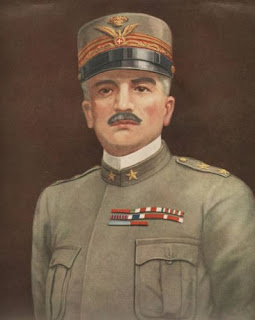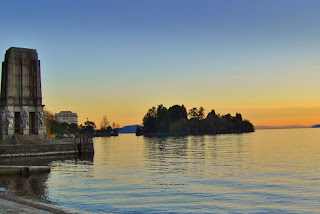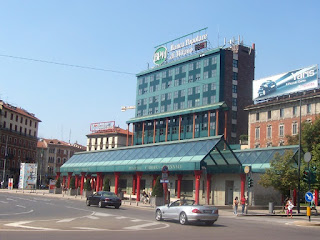Tough military leader was blamed for losing crucial battle
 |
| General Luigi Cadorna was Chief of Staff of the Italian Army in the First World War |
Luigi Cadorna, a military General who was made a Marshall of
Italy, was born on this day in 1850 in Verbania, on the shore of Lake Maggiore
in the Piedmont region.
Cadorna is most remembered for his role as Chief of Staff of
the Italian Army during the first part of the First World War.
His father was General Raffaele Cadorna, the Piedmontese military leader whose capture of Rome in 1870 completed the unification of Italy.
Sent by his father to a
military school in Milan from the age of 10, he entered the Turin Military Academy when he was 15
and, after graduating at the age of 18, was commissioned as a second
lieutenant of artillery.
He participated in the occupation of Rome in 1870 as part of the force commanded by his father.
After becoming a Major, Cadorna was appointed to the staff
of General Pianelli and became Chief of Staff of the Verona Divisional Command.
From 1892 he was the Colonel commanding the 10th Regiment of
Bersaglieri, where he acquired a reputation for strict discipline and harsh
punishment.
He was promoted to lieutenant general in 1898 and
subsequently held a number of senior command positions.
 |
| General Cadorno (fourth from the right) inspecting Italian troops ahead of the second Isonzo offensive |
By 1915, when Italy was about to enter the First World War, Cadorna
was on the verge of retiring and had a history of differences with his
political and military superiors.
But he was offered the post of Chief of Staff and took Italy
into the war with 36 infantry divisions composed of 875,000 men, armed with
only a small number of modern artillery pieces.
Large numbers of men and equipment had been deployed to
Tripolitania in Libya, leaving the home army disorganised and short of equipment.
Cadorna launched four offensives along the Isonzo river with
the aim of capturing Gorizia from the Austrians, but they all failed, leaving 250,000 Italian
casualties.
Cadorna would ultimately fight 11 unsuccessful battles in
unsuitable terrain between 1915 and 1917.
In October 1917, a combined Austro-Hungarian army advanced,
defeating Cadorna’s troops at Caporetto. The troops managed to get as far as
the Piave River, because Cadorna’s tactics had provided little defence in
depth.
 |
| General Armando Diaz led the defeat of the Austro-Hungarian army after replacing Cadorna |
The Italian army fled in disarray and seemed on the verge of
total collapse, with 275,000 soldiers captured.
During the battle, Cadorna had ordered the execution of all
officers whose units retreated.
Italy’s allies, Britain and France, insisted on the
dismissal of Cadorna and sent 11 divisions to reinforce the Italian front.
Italian Prime Minister Vittorio Orlando appointed General
Armando Diaz as Chief of General Staff and Cadorna was reassigned to be the
Italian representative at the Allied Supreme War Council set up in Versailles.
The restored Italian defensive line held firm during the
Battle of the Piave River, providing a springboard for the Battle of Vittorio
Veneto, where the Austro-Hungarian army was finally defeated.
After the war, the Italian Government held an inquiry into
the defeat at Caporetto and the published report was critical of Cadorna.
He wrote in his memoirs that he was not responsible for the
defeat, despite having fled to Padua during the battle.
In 1924, after Benito Mussolini seized power, Cadorna was
made a Field Marshall (Maresciallo d’Italia), an honour recognising his service
to Italy before and during the war. Cadorna died in Bordighera in 1928 at the
age of 78. His body was entombed in a mausoleum designed by the architect Marcello Piacentini by the waterside at Verbania.
His son, Raffaele Cadorna, also became a General, fighting
in the First and Second World Wars. He became famous for his actions as one of the
commanders of the Italian Resistance, fighting against the Germans who were
still occupying northern Italy after 1943.
 |
| A picture taken from Verbania at sunset with the Cadorna Mausoleum in the foreground and Isolina di San Giovanni |
Travel tip:
Verbania, where Luigi Cadorna was born, is a town on the
shore of Lake Maggiore, about 91km (57 miles) northwest of Milan and about 40km (25 miles) from Locarno in Switzerland. Verbania is also known as Verbania
Pallanza, following its merger with Intra, Pallanza and Suna in 1939. It faces
the city of Stresa across the lake. A small island a few metres from the shore,
known as the Isolino di San Giovanni, is famous for having been the home of
Arturo Toscanini, between 1927 and 1952.
Milano Cadorna railway station in Piazzale Luigi Cadorna,
near the Castello Sforzesco, provides a permanent reminder of the General to
all rail commuters. The original station building was destroyed by bombing in the Second World War and the current building was restored, along with the square, in
1999. Piazzale Cadorna is now a Milan transport hub with an underground
station, tram stops and 11 bus stops.




